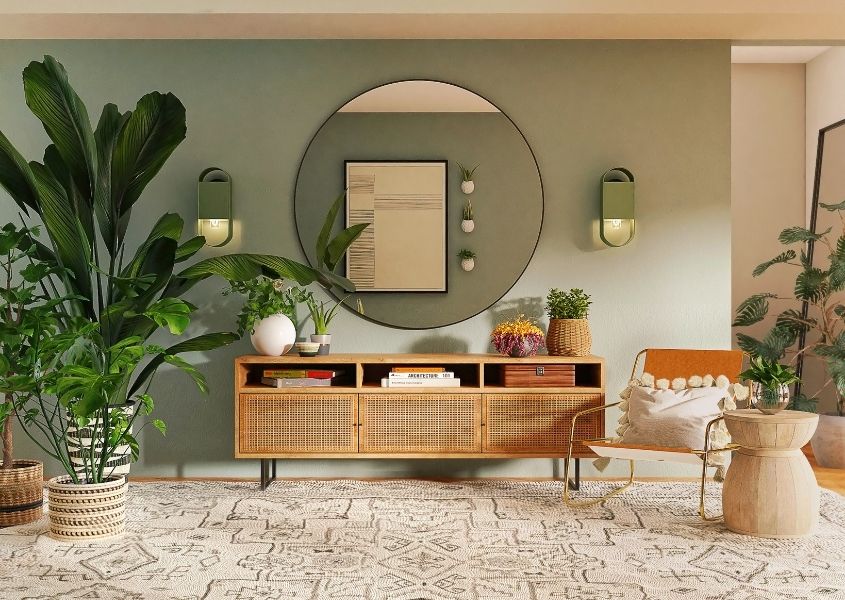An eco-friendly home makeover is an excellent way to make your home more sustainable and reduce your carbon footprint. With a few simple upgrades, you can create a healthier living space for you and your family while also saving money on energy bills. Here are some sustainable upgrades for every room in your home.
Living Room
The living room is often the central gathering place in a home, and there are several ways to make this room more eco-friendly.
Furniture: Consider using furniture made from sustainable materials such as bamboo, reclaimed wood, or recycled plastic. These materials are environmentally friendly and often last longer than traditional materials. Look for furniture with certifications like the Forest Stewardship Council (FSC) or the Rainforest Alliance.
Lighting: Use energy-efficient lighting to reduce energy consumption. LED bulbs are the most energy-efficient and long-lasting, and they also come in a range of brightness levels. Consider installing dimmer switches to adjust the brightness and create the perfect ambiance.
Plants: Incorporating houseplants into your decor can improve air quality and add a touch of natural beauty to your living room. Plants absorb carbon dioxide and release oxygen, helping to improve air quality in your home.
Kitchen
The kitchen is often one of the most energy-intensive rooms in a home, but there are several ways to make it more sustainable.
Appliances: Choose energy-efficient appliances with an Energy Star rating. These appliances use less energy than conventional appliances and can help you save money on your energy bills. Also, consider purchasing smaller appliances that use less energy and produce less waste.
Containers: Use reusable containers to store food and avoid single-use plastics. This will not only reduce your waste but also save you money over time.
Water: Install a water-efficient faucet to conserve water. Look for faucets that have a WaterSense certification. Consider composting food waste to reduce the amount of waste you produce.
Bathroom
The bathroom is another energy-intensive room in a home, and there are several upgrades you can make to make it more sustainable.
Water: Install a low-flow showerhead and faucet to conserve water. Low-flow fixtures can reduce your water consumption by up to 60%. Also, consider installing a dual-flush toilet, which allows you to choose between a full flush and a partial flush, reducing water usage.
Cleaning Products: Use organic or natural cleaning products to avoid harsh chemicals that can harm the environment and your health. You can also make your own cleaning products using simple ingredients like vinegar and baking soda.
Toilet Paper: Swap out conventional toilet paper for recycled or bamboo toilet paper. These alternatives are more sustainable than traditional toilet paper, which comes from trees.
Bedroom
The bedroom is where you spend a significant amount of time sleeping, so it is important to make this room as eco-friendly as possible.
Bedding: Use organic bedding made from materials like cotton, linen, or bamboo. These materials are grown without harmful chemicals and are environmentally friendly. Also, consider using wool or down comforters, which are naturally insulating and can help you save money on heating and cooling costs.
Mattress: Choose an eco-friendly mattress made from natural latex or organic cotton. These mattresses are free from toxic chemicals that can harm the environment and your health. They also last longer than traditional mattresses, reducing waste.
Curtains: Use blackout curtains to improve energy efficiency and reduce heating and cooling costs. Blackout curtains block out sunlight, keeping your bedroom cooler in the summer and warmer in the winter.
Home Office
Many people are working from home these days, and there are several ways to make your home office more sustainable.
Electronics: Use a power strip to turn off electronics when not in use. Electronics can continue to draw energy even when they are turned off, so a power strip can help you save energy and reduce your energy bills.
Laptop: Consider using a laptop instead of a desktop computer to reduce energy consumption. Laptops use less energy than desktop computers, making them a more sustainable option.
Desk: Choose a desk made from sustainable materials like bamboo or reclaimed wood. These materials are eco-friendly and durable. You can also look for desks that are adjustable, allowing you to stand and work, reducing your time spent sitting.
Conclusion
Making your home more eco-friendly is a great way to reduce your carbon footprint, save money, and create a healthier living space for you and your family. By making simple upgrades to every room in your home, you can make a significant impact on the environment and your quality of life. Whether you’re looking to reduce your energy consumption, conserve water, or reduce waste, there are plenty of sustainable upgrades you can make to create a more eco-friendly home. Start with the tips outlined in this article and continue to look for ways to make your home more sustainable.

